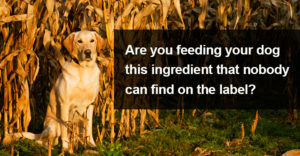It’s a sad fact that dogs are dying younger than they used to. They’re getting more cancers and other chronic diseases than ever before. Do you wonder why that’s happening?
Well … there are a few mistakes dog owners make, that may harm their dogs. It’s with the best intentions … and they’re often things your veterinarian recommends! But you might be able to make some changes that’ll improve your dog’s chances of a longer, healthier life.
Here are some of the most common mistakes dog owners make.
Mistake #1 Vaccinating Puppies Too Young
So, your new 8-week old puppy is the cutest thing ever … and you want to make sure you keep him safe. But the typical approach of vaccinating him every two weeks isn’t the best way to do that.
Sure, you want to make sure he doesn’t get parvovirus or distemper. But there’s a trade-off … between the risk of disease and the risk of over-vaccinating your puppy. And this is why it’s #1 on the list of mistakes dog owners make. Over-vaccinating your puppy can damage him for life.
The risks include lifetime chronic diseases. Problems like allergies, arthritis, digestive disease, autoimmune disease … and even cancer. So, ideally … you want to minimize the number of vaccines your puppy gets.
The conventional practice is to vaccinate puppies every two weeks or so until 16 weeks old.
Why Vets Over-Vaccinate Puppies
Younger puppies get maternal antibodies from their mother’s milk. Antibodies protect them from disease until they wear off after a few weeks. But those antibodies will also block the vaccine.
Your vet is trying to vaccinate when the maternal antibodies are gone … but your puppy isn’t yet at risk from viruses in his environment. So they jab your puppy every two weeks, hoping to catch that window. And that means your puppy gets far too many vaccinations! But there’s a better way.
Your puppy only needs one vaccination at the right time to be protected from disease! So instead of vaccinating over and over again … follow the recommendation of veterinary immunologist Ronald Schultz PhD.
Based on his decades of research into duration of immunity vaccines, Dr Schultz recommends giving …
- Only one vaccination for parvo, distemper and adenivorus … between the ages of 12 and 16 weeks
Following Dr Schultz’s recommendation will protect your puppy from disease, without over-vaccinating him.
Mistake #2 Repeating Vaccines Unnecessarily
You probably get a vet reminder every year to bring your dog in for his vaccines. As many as 60% of vets are still vaccinating dogs annually. And that’s really dangerous for your dog! Over-vaccination can cause lifelong problems for your dog … like autoimmune disease, cancer and other chronic conditions.
And it’s also completely unnecessary. Dr Schultz proved it with his research. Most dogs are protected for life by the shots they got as puppies (1).
Dr Schultz has stated …
Vaccines for diseases like distemper and canine parvovirus, once administered to adult animals, provide lifetime immunity.
Ronald D Schultz PhD
But for some reason, many vets ignore his science … and still recommend annual vaccinations. And others are recommending vaccination every 3 years. Even that’s unnecessary. The protection from a vaccines like parvovirus usually lasts for life. And it’s the same for another core vaccine … distemper. The distemper vaccine is a highly effective vaccine that protects for life after one shot. And if your vet doesn’t agree with that … you can get a titer to prove it.
Titers For Dogs
Titers are blood tests that show the level of protection your dog has to a specific disease. So ask your vet for a titer … instead of just blindly re-vaccinating your dog (2)
Now … some vets charge exhorbitant fees for titers. (Perhaps because they’d rather keep vaccinating your dog every year?) You don’t have to pay them. Instead, ask your vet to draw the blood and give you the sample. Mail it yourself to Hemopet, where a distemper plus parvo titer currently costs $55.
Titers can also be useful when your groomer, boarding kennel or trainer asks for vaccine records. Many of them will accept titers as proof your dog is protected. And if they don’t, you might want to find a different provider!
But … once you have a positive titer, you shouldn’t need to do another one. According to Dr Schultz’s research, a single positive titer shows that your dog is protected. Repeating titers after you have a positive result is unnecessary. That’s because titers measure circulating antibodies … and if your dog isn’t exposed to the disease for a while, the antibodies stop circulating. But they are still there in your dog’s cellular memory, ready to protect your dog if he does get exposed.
Mistake #3 Giving Combo Vaccines
Combination vaccines are also called polyvalent vaccines. Monovalent vaccines only contain one virus. Polyvalent vaccines contain many viruses … and bacteria too. These combinations are usually shown on your vet statement as DHLPP, DHLPPC, DA2LPPC, and so on. Many holistic vets call these polyvalent vaccines whombo combos. And these same holistic vets strongly advise against giving them.
Unless you’ve firmly told your vet no, thank you, your dog has probably received a combination vaccine or two in his lifetime. Conventional vets … and lots of shelters and rescues … do it because it’s easier (and cheaper) than splitting the shots up into individual ones. And it means your dog will almost certainly get more vaccines than he actually needs.
For example, when you see the ‘L’ in the names above, that’s Leptospirosis. A vaccine you probably didn’t want to give … because it’s high risk and doesn’t work very well. Any many dogs have lifestyles that don’t expose them to lepto risk … but it’s in the cocktail your dog got!
But the worst thing of all … is the assault on your dog’s body. Injecting all these different viruses (or bacteria) at once isn’t safe! Your dog’s immune system is supposed to handle one virus. Not 5 or 6 at the same time! It’s already risky giving just one vaccine. Many holistic vets will tell you … combo shots have much higher rates of adverse reactions. That’s especially true in small dogs and puppies.
So ask your vet not to give them. If your vet doesn’t carry monovalent vaccines … you may need to buy them yourself. But it’s worth it to protect your dog from harm!
Mistake #4 Giving Non-Core Vaccinations
Core vaccines are the “big” ones your dog usually gets as a puppy. If you decide to vaccinate your dog, the core vaccines are the important ones. They’re the ones that can protect your dog from life-threatening diseases:
- Rabies
- Parvovirus
- Distemper
- Adenovirus (Canine hepatitis)
But then there are the non-core vaccines that many vets recommend. Here are the main ones.
- Bordetella (Kennel Cough)
- Leptospirosis
- Canine Influenza
- Lyme disease
These vaccines don’t protect your dog from disease very effectively … but they carry high risk of adverse reactions. So if your vet wants you to give any non-core vaccines, click on the article about non-core vaccines below to read why you should politely decline.
You’ll also find many boarding kennels, groomers and trainers asking for proof of non-core vaccines. They often ask for Bordetella (Kennel Cough) and Canine Influenza. What they’re afraid of is your dog getting sick on their premises. So some will let you sign a waiver of liability.
And if they won’t … consider protecting your dog from these risky vaccines by finding a different facility!
Mistake #5 Feeding Kibble
How would you like to eat cornflakes for every meal … every day of your life? Because, when you feed kibble, that’s what you’re giving your dog. Imagine the boredom of the same food … day in, day out. But the real problem is that the nutrition is so poor. Remember they used to say there was more nutrition in the box … than in the actual cornflakes? Well that’s true of a lot of kibble too!
Here are 4 important reasons you should stop giving your dog kibble:
#1 Kibble Is Fake, Dead Food!
Kibble is processed at high temperatures. The heat kills what little nutrition there is in the original ingredients.So they add in a bunch of synthetic vitamins and minerals … then they can call it “complete and balanced.”
Synthetic vitamins and minerals aren’t well absorbed by your dog’s body … and they can even be harmful long-term. So that means kibble doesn’t provide your dog with good nutrition.
#2 Kibble Is High In Starchy Carbohydrates
It has to be … that’s what holds those little kibble pellets together. Your dog doesn’t need starch in his diet. Starch creates an unhealthy gut … causing digestive and other issues. It leads to long-term chronic conditions … like allergies and skin problems.
#3 Kibble Is Bad For Your Dog’s Teeth
Contrary to what kibble makers tell you … kibble does not clean your dog’s teeth! The food contains no live enzymes or natural nutrients … and all those starches stick to the teeth … so kibble leads to dental issues.
Most kibble-fed dogs have to go under anesthesia every year or so to have their teeth cleaned. Most raw fed dogs naturally have clean teeth and don’t need veterinary dental cleanings.
#4 Kibble Contains Carcinogens
This is the most vital reason of all to avoid kibble. Your dog’s food could be giving him cancer!
Kibble contains toxins … like aflatoxins, heterocyclic amines, acrylamides and PBDEs (flame retardant chemicals!). These are harmful chemicals your dog shouldn’t eat! And, by the way … these problems are just as bad in all kibbles. Even “premium” kibbles and expensive veterinary prescription foods!
So do your dog a favor and get him on a whole food, preferably raw meat-based diet. It might seem expensive … but you’ll probably save with lower vet bills!
RELATED: Kibble: why it’s not a good option for your dog …
Feed Fresh Food
If you’d like to prepare DIY raw food, click on the link to our raw recipes below. Or … you can buy a good pre-made frozen raw food. The next best option is freeze-dried raw food. It’s just as convenient as kibble (though more expensive).
Dehydrated food is another option. Dehydration uses heat so there’ll be some nutrient loss. Or if you can’t quite bring yourself to feed raw … feed a whole food, cooked diet. Or, at the very least … make kibble more nutritious by adding some kibble boosters.
Mistake #6 Giving Heartworm Drugs
Heartworm is a word that strikes terror into dog owners’ own hearts! And conventional veterinarians love to increase that terror. Because they’re afraid of heartworm too. They show you gory pictures of spaghetti-like worms in dogs’ hearts. Then they tell you how horrible the conventional treatment for heartworm is.
But once again … there’s a trade-off. The risks of heartworm preventive drugs can be worse than the risk of your dog getting heartworm. Here are some problems wth heartworm medications.
Heartworm Preventives
Well … preventive isn’t the right word. Because they don’t prevent anything. They just kill heartworms that are already in your dog. So … if you give them to your dog and he doesn’t have heartworms … you’re giving him a drug he doesn’t need. And a drug that has some serious risks …
Heartworm Drugs Are Neurotoxins
They kill the heartworms by paralyzing them. And that means they can also harm your dog’s nervous system. And they do. Some of the side effects of these drugs include problems like convusions, ataxia and trembling.
Heartworm Isn’t As Common As You Think
The American Heartworm Society publishes maps of heartworm incidence. The most recent map for 2019 shows:
- Much of the country has fewer than 1 case per clinic
- Most places have less than 5 cases per clinic
So ask your vet how many cases they’ve treated before you worry about heartworm where you live!
There Are Safer Alternatives
You can find safer, natural options to prevent and treat heartworm. You can buy herbal blends, or use homeopathic remedies or other natural protocols. Ask your holistic vet about them.
Mistake #7 Applying Toxic Pest Repellents
It seems like every year, we’re told this is going to be the worst year for ticks ever. And ticks are scary because they can transmit diseases to your dog. Fleas are more of an annoyance than a danger. But they can certainly turn your household upside down if your dog gets an infestation.
But many of the pharmaceutical options to prevent these pests … are downright dangerous. They’re pesticides … and they come in two different formats.
Oral Drugs
These days you can buy an oral drug that’s supposed to protect your dog from pests for a month –or three. But the problem with these drugs is they have some serious side effects. They include really serious reactions … like seizures and even death! There are social media groups and forums where pet owners describe some of the horrors.
And because these drugs are oral … once they’re in your dog, he’s stuck with them. So if he has a reaction … you have no way to get them out of his system.
Spot-On Products
The spot-on products may seem safer. And of course, the makers claim your dog’s organs don’t absorb the pesticides.
But there’s research showing that’s not true. Veterinarian Dr Deva Khalsa has seen data from the EPA’s Pesticide Division. It shows that fipronil enters the body and can be contained in the fat, organs, urine and feces of dogs. Fipronil is the main ingredient in Frontline, one of the most popular spot-ons.
So … there are safer, more natural ways to keep pests off your dog. You can buy natural sprays to keep the bugs away … or use DIY insect repellent recipes.
Mistake #8 Treating Dogs With Pharmaceuticals
Giving your dog medications has its own set of risks. Here are a couple of important ones … antibiotics and NSAIDs.
Antibiotics
So … let’s say your dog has an infection. And your vet says he needs antibiotics. What do you do? Surely a few days of pills can’t hurt too much, right? That’s what conventional vets think. So they use them for everything … even sometimes as a “just in case” treatment.
But unfortunately …antibiotics can have long-lasting effects on your dog’s gut health.
Gut health is vital to overall health. About 90% of your dog’s immune system starts in the gut … where the good bacteria (or probiotics) live. Antibiotics kill all bacteria. Not just the bad ones … but also the good ones that protect him from disease. So this is worse than just a bit of tummy upset.
In fact, research shows that the gut never really recovers from antibiotic use. So gut damage can mean lowered resistance to all kinds of disease … for life.
Save Antibiotics For Serious Problems
Antibiotics cam be life-saving. And that’s when you should use them. So, before you agree to give your dog antibiotics for a minor problem … do some research into natural antibiotic solutions. You may find there’s a safer way to help your dog.
Don’t use antibiotics for things like skin problems or diarrrhea. That’s a frivolous use of antibiotics. And it can cause long-lasting damage to your dog’s health. Save antibiotics for those few times when nothing else will do … meaning a life-threatening illness or emergency.
NSAIDs
NSAIDs are non-steroidal anti-inflammatory drugs. Names like Rimadyl and Metacam likely sound familiar to you. Vets hand them out liberally! They use them for everything! From pain after surgery … to arthritis or sprains and strains. And it’s not that they don’t help reduce pain and inflammation. They do. But it comes at a cost.
One major problem is that NSAIDs actually cause joint damage! Yes, that’s right! The very thing you’re trying to treat with these drugs can get worse!
Homeopathic veterinarian Dr Todd Cooney says “ditch the NSAIDs.” Read his alarming information about the side effects of NSAIDs … and his advice for what to do instead.
Suppressing Symptoms Isn’t A Cure
In general … most drugs don’t actually cure anything. What they do is suppress symptoms. And that drives the disease deeper into the body … where it may come back in another (worse) form. That could even be cancer. Natural solutions like homeopathy or small herbal doses support the body’s own healing. And they do it without suppressing symptoms.
It’s a really good idea to find a homeopathic or holistic vet… before you need one in an emergency. Then you’ll have some much safer options when your dog has a problem.
Mistake #9 Using Toxic Chemicals In Your Home And Yard
So far we’ve talked about lots of things you can do (or stop doing) … to protect your dog when he’s out and about. But what about in his very own home? Are you using toxic chemicals in your house and yard?
EWG (Environmental Working Group) reported back in 2008 … that pets have high levels of toxic industrial chemicals in their bodies (3). It’s unlikely that situation has improved today.
First, your yard. There’s research showing that lawn chemicals increase the risk of cancer in dogs. So, instead of chemical herbicides and fertilizers … look for natural solutions.
- Use white vinegar to kill weeds
- Buy chemical-free, organic fertilizers
- Make your own compost from yard and kitchen waste
Inside your house … it’s even more important to use chemical-free cleaners. Keep in mind your dog lives on or near the floor most of the time. So he’s breathing in those toxins constantly. And once again, the chemicals in many cleaning products are harmful … even carcinogenic.
Use safe products like white vinegar and baking soda to clean your home. You’ll protect your dog and save money too!
Artificial Fragrances
One other category to avoid is artificial fragrances. These include …
- Room sprays
- Deodorizing sprays
- Scented candles
- Laundry dryer sheets
- Your own soap, body lotion, perfume or cosmetics
These all contain chemicals that can harm your dog.
If you walk around your neighborhood, the fake perfumes from dryer vents are sickening. So imagine how dogs feel, with their much more sensitive noses. And some people use dryer sheets to “touch up” their dogs’ coats … instead of giving a bath. Don’t do this, please – they’re toxic!
Again, seek out natural solutions to household odor problems … even if your dog is causing them! A little baking soda can go a long way!
Mistake #10 Bathing Your Dog With Harmful Shampoos
You might not think bathing your dog is risky … but you’d be surprised. Even shampoos that seem natural often contain harmful ingredients. Melissa Boland learned about these ingredients after she and her dog both got cancer. So she’s done the research to help you keep your dog safe. Here are her Top 20 Dog Shampoo Ingredients To Avoid.
And beware … because lots of shampoos don’t disclose all the ingredients on the label. So you might need to call the company to get a full list.
Do your homework though … it’s worth it for your dog’s sake! Buy an organic, chemical-free shampoo for his spa days!
BONUS Mistake: Thinking “Natural” Really Is Natural!
You might read an ingredient label and see the word natural. This could be dog treats, food, shampoo or supplements. So you think it’s OK to use them for your dog. Unfortunately, that’s often wrong. Most of the time, ingredients described as “natural” … aren’t natural at all.
Natural is just a marketing term. There’s nothing to regulate its use. So don’t believe them. Do your own research and find out if they’re misleading you. You’ll often see terms like these:
- Natural flavor
- Natural beef (or other meat, like bacon) flavor
- Natural fragrance
Again … there are no regulations about using the word “natural.” The FDA (Food & Drug Administration says:
“The term “natural” is often used on pet food labels, although that term does not have an official definition.”
In fact, this happens in human products too. Here’s the FDA’s warning about what “flavor” means on food packaging. And check out this study reported by EWG (4). Almost half of all “natural” personal care products contain a known carcinogen. You can bet it’s no better in dog products! So … don’t believe what the advertising or even the label says!
Always do your research. If there are names you don’t recognize on the ingredient list … look them up. If the word looks unfamiliar, chances are it’s a synthetic chemical.
Small changes make a big difference. It’s worth the extra work to protect your dog’s health and longevity.
References
1. Ronald D Schultz PhD. Proceedings of the 2008 Annual Conference of the AHVMA.
2. Jensen WA, Totten JS, Lappin MR, Schultz RD. Use of serologic tests to predict resistance to Canine distemper virus-induced disease in vaccinated dogs. J Vet Diagn Invest. 2015 Sep;27(5):576-80.
3. Environmental Working Group. Polluted Pets. ewg.org, April 17 2009.
4. Environmental Working Group. Study: Almost Half Of All ‘Natural’ Personal Care Products Contain Known Carcinogen. ewg.org. March 14 2008.













